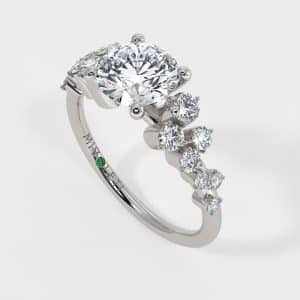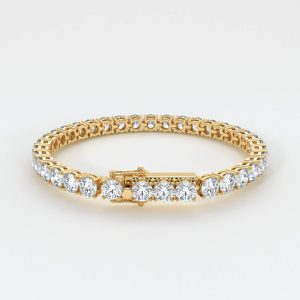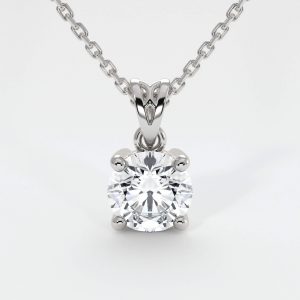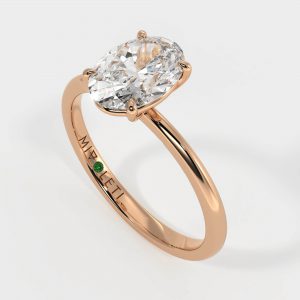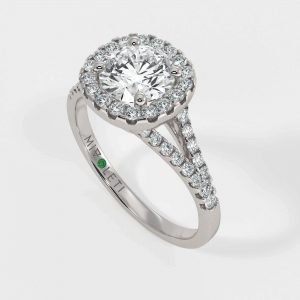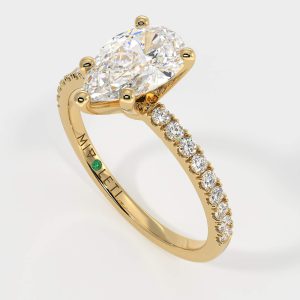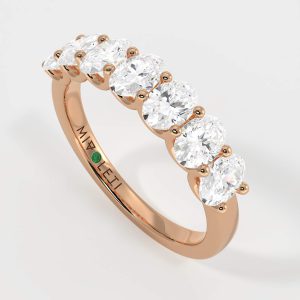The Sparkling Origins: Understanding Diamonds and Their Natural Formation
Diamonds, revered for their unparalleled brilliance, are natural carbon crystals formed under conditions of immense pressure and high temperature deep within the Earth’s mantle. These gemstones result from complex processes that span billions of years, making their origins a remarkable testament to nature’s enduring artistry. The journey of natural diamonds begins approximately 90 to 140 miles beneath the Earth’s surface, where the combination of extreme heat and gravitational pressure provides the ideal conditions for carbon atoms to bond in a unique tetrahedral structure.
The carbon required for diamond formation typically originates from organic material buried deep within the Earth’s crust. Over millions of years, this carbon undergoes gradual transformation, driven by intense geological activity. Through tectonic plate movements, volcanic eruptions, and mantle dynamics, diamonds are eventually propelled closer to the Earth’s surface, most commonly via kimberlite pipes—volcanic conduits that form during magma eruptions.
Key factors influencing diamond crystallization include pressure, temperature, and the presence of essential minerals within the surrounding rock. For diamond formation, temperatures of approximately 1652–2372°F and pressures of up to 725,000 pounds per square inch are essential. Under these conditions, carbon atoms align and crystallize, creating the distinct crystalline lattice that gives diamonds their unparalleled hardness—a score of 10 on the Mohs scale.
Natural diamonds often emerge alongside other rare minerals, such as olivine and garnet, within host rocks, allowing geologists to trace their origins. Broadly, diamond recovery requires meticulous mining techniques, and the diamonds uncovered serve as treasured snapshots of the Earth’s geological history. Understanding this extraordinary process underscores the rarity of natural diamonds and highlights the intricate interplay between time, pressure, and natural phenomena that gives rise to their unmatched allure.
Early Experiments: The Quest for Creating Diamonds in a Lab
The pursuit of creating diamonds outside the Earth’s crust dates back to the late 19th century. Early experiments were driven by scientific curiosity and the promise of industrial applications, as natural diamonds were a scarce and costly resource. Early innovators explored ways to mimic the high-pressure, high-temperature conditions found deep within the Earth’s mantle, where natural diamonds form over billions of years.
In 1879, Scottish scientist James Ballantyne Hannay attempted to synthesize diamonds by combining bone oil and lithium within a closed iron tube, then subjecting the mixture to extreme heat. Although his results were debated and unverified, his work laid the foundation for future scientific inquiry. In the early 20th century, American chemist Charles Parsons also sought to replicate diamond creation. Parsons used electrical furnaces to apply significant heat and pressure to carbon-based substances, but his experiments ultimately proved inconclusive.
The turning point came in the 1940s when General Electric (GE) launched “Project Superpressure.” With advancements in technology and industrial equipment, GE’s researchers were able to achieve unprecedented conditions to stimulate diamond growth. In 1954, scientist Tracy Hall and his colleagues successfully created the first synthetic diamond using the High-Pressure, High-Temperature (HPHT) method. By compressing graphite under pressures exceeding 1.5 million pounds per square inch and temperatures above 2,700°F inside a press, they developed small, yet genuine, diamonds.
This breakthrough officially marked the beginning of lab-grown diamonds, primarily intended for industrial uses such as cutting tools and abrasives. However, research continued, improving the quality, size, and purity of synthetic diamonds. These early experiments set the stage for the modern era, where lab-grown diamonds rival their natural counterparts in luxury and aesthetic value.
The Breakthrough: When Lab Grown Diamonds Became a Reality
The journey toward cultivating diamonds in a laboratory began in the mid-20th century, fueled by scientific curiosity and industrial demand. Early attempts to replicate Earth’s natural diamond formation focused on mimicking extreme pressures and temperatures, a process perfected over billions of years deep within the planet’s mantle. By the 1950s, researchers successfully created the first synthetic diamonds, though they were small and primarily suitable for industrial applications such as cutting and grinding tools.
The real breakthrough in lab-grown diamonds for jewelry arrived decades later with advancements in two pioneering technologies: High Pressure, High Temperature (HPHT) and Chemical Vapor Deposition (CVD). These methods allowed scientists to create diamonds of greater size, clarity, and quality, rivaling the aesthetics and physical properties of their mined counterparts. HPHT works by subjecting a carbon source to high pressures and extreme temperatures, replicating the natural diamond-forming conditions in a controlled environment. Meanwhile, CVD employs a vacuum chamber to grow diamonds atom by atom using a hydrocarbon gas mixture, offering even more precision and control over the final product’s purity.
The advent of these technologies marked a revolutionary shift in the diamond industry. Concerns over ethical sourcing and environmental sustainability had grown substantially, tarnishing the reputation of mined diamonds. Lab diamond production offered a transparent and traceable alternative, free from the conflicts associated with traditional diamond mining.
By the early 2000s, lab-grown diamonds had begun finding acceptance in the luxury market. Jewelers and consumers embraced the idea that these diamonds—formed with the same crystal lattice structure as mined ones—delivered identical brilliance. They also offered competitive pricing, positioning them as a sustainable, science-driven innovation at the intersection of luxury and responsibility.
Technological Advancements: CVD vs. HPHT Methods Explained
Lab-grown diamonds are crafted using two primary methods: Chemical Vapor Deposition (CVD) and High-Pressure High-Temperature (HPHT). Both techniques replicate the conditions under which natural diamonds form, but they differ fundamentally in their processes and technological approaches.
High-Pressure High-Temperature (HPHT) Method
The HPHT method mimics the natural diamond formation process by subjecting a diamond seed to intense pressure and high temperature. This occurs within pressurized chambers, which can reach pressures of up to 60,000 atmospheres and temperatures exceeding 2,000°C. The process begins with a small diamond seed, typically made of carbon, placed within a growth medium. Under these extreme conditions, carbon atoms crystallize around the seed, forming a diamond.
HPHT diamond growth is facilitated through press technologies such as cubic presses, belt presses, or split-sphere presses. The result is structurally identical to mined diamonds, offering both remarkable clarity and hardness. Manufacturers can even refine HPHT-grown diamonds post-creation to enhance color characteristics, making the process versatile for producing colorless or fancy-colored diamonds.
Chemical Vapor Deposition (CVD) Method
The CVD method employs a plasma chamber where a diamond seed is exposed to hydrocarbon gases like methane. These gases are combined with hydrogen and subjected to high-energy plasma, breaking down the molecular structure of the gas. The carbon atoms then precipitate onto the diamond seed, layer by layer, forming the diamond.
Unlike HPHT, the CVD process requires lower temperatures, typically ranging between 800°C and 1,200°C, making it more energy-efficient. It allows for meticulous control over diamond growth, providing uniformity in size and structure. Additionally, the CVD method is acclaimed for producing diamonds with exceptional purity due to reduced metal inclusions in comparison to HPHT diamonds.
Differences and Applications
HPHT and CVD differ in practical aspects, such as cost, speed, and diamond quality. HPHT is often used for fancy-colored diamond creation due to its ability to manipulate trace elements. CVD, meanwhile, is preferred for consistency in colorless diamonds and for scientific applications within semiconductors and optics.
By leveraging these technological innovations, manufacturers can cater to various market demands, from luxury jewelry to industrial applications—all while maintaining eco-friendliness and affordability in comparison to mined diamonds.
Shaping Perception: How Lab Grown Diamonds Gained Popularity
Lab grown diamonds have steadily carved a prominent place in the luxury jewelry market, reshaping the perception of what constitutes genuine elegance. Their surge in popularity can be attributed to an interplay of technological advancements, shifting consumer attitudes, and alignment with environmental concerns. By replicating the very conditions under which natural diamonds form, advanced laboratory techniques have ensured that lab grown diamonds are visually and chemically indistinguishable from their mined counterparts. This scientific accuracy has played a pivotal role in establishing lab grown diamonds as legitimate alternatives in the luxury sector.
Consumer awareness has also been a driving force. As modern buyers become increasingly informed, many are drawn to the ethical and sustainable narrative surrounding lab grown diamonds. Unlike traditional diamond mining, which often carries a history of conflict zones and environmental degradation, laboratory-grown stones are perceived as more socially responsible. This appeal has resonated with younger generations, particularly Millennials and Gen Z, who are keen on aligning their purchasing power with values of sustainability and global accountability.
Moreover, pricing dynamics play a substantial role. Lab grown diamonds generally cost 20-40% less than mined diamonds of comparable quality, making luxury jewelry more accessible to a broader audience. This affordability enables consumers to invest in higher-carat options or superior-grade stones without sacrificing quality or aesthetics. Retailers, too, have been quick to adapt, dedicating significant marketing resources to showcasing lab grown alternatives as viable symbols of sophistication and prestige.
The influence of celebrities, influencers, and industry leaders cannot be overlooked. Public endorsements of lab grown diamonds, paired with red-carpet appearances, amplify their aspirational appeal. These endorsements, often hailed as progressive choices in a globalized world, validate lab grown diamonds in the eyes of discerning buyers. Through bold campaigns and media representation, lab grown diamonds continue to be redefined, positioning innovation as luxury’s new cornerstone.
Such factors collectively have reimagined the diamond industry, emphasizing that beauty, brilliance, and responsibility can coexist seamlessly in luxury jewelry.
Ethical and Environmental Benefits of Lab Grown Diamonds
Lab-grown diamonds offer a significant shift in the diamond industry, addressing long-standing concerns about ethical sourcing and environmental impacts. Unlike mined diamonds, which often require intensive labor practices and large-scale extraction, lab-created diamonds are grown in controlled laboratory settings, ensuring minimal disruption to ecosystems and eliminating ethical controversies tied to traditional mining methods.
Ethical Advantages
Conflict-Free Production: Lab-grown diamonds eliminate the risk of financing armed conflicts or labor exploitation, issues prevalent in certain diamond mining regions. Buyers can select these diamonds with confidence, knowing they uphold fair and humane practices. Transparency in Sourcing: The production of lab-grown diamonds provides full traceability from raw materials to finished gemstones. This level of transparency gives consumers peace of mind about the origin and manufacturing process. Fair Labor Conditions: With lab-grown diamonds, the need for labor-intensive mining operations is removed. Instead, workers in laboratory environments benefit from regulated working conditions, adhering to health and safety standards that mining operations often lack.
Environmental Benefits
Reduced Carbon Footprint: Traditional diamond mining entails vast energy usage and carbon emissions. Lab-grown diamonds, produced through advanced technological processes, use significantly less energy, aligning with global efforts to decrease carbon output. Minimized Land Disruption: Mining involves deforestation, soil displacement, and water contamination. Conversely, creating diamonds in labs avoids damaging local ecosystems and preserves biodiversity. Water Conservation: Lab-grown processes utilize far less water compared to mining operations, which can deplete and pollute local water resources in affected regions.
Lab-grown diamonds exemplify a modern approach that caters to environmentally conscious and ethically driven consumers. By addressing issues inherent to historical diamond sourcing, these gems redefine luxury jewelry with responsibility and innovation at the forefront.
Comparing Lab Grown vs. Natural Diamonds: Key Differences and Similarities
Understanding the contrasts and commonalities between lab-grown and natural diamonds is essential to make informed decisions when selecting diamond jewelry. Both options share intrinsic qualities that make them valuable, yet differ in terms of origin, pricing, and ethical considerations.
Similarities
Lab-grown diamonds and natural diamonds are chemically and structurally identical. They consist of pure carbon atoms arranged in a crystal lattice, resulting in the same durability, brilliance, and refractive qualities. Both diamonds are graded using standardized criteria, such as the “Four Cs†— cut, color, clarity, and carat weight. Additionally, both types of diamonds exhibit the timeless sparkling aesthetic that appeals to consumers and drive their popularity.
Key Differences
1.Formation Process: Natural diamonds are formed over billions of years under extreme pressure and temperature deep within the Earth’s mantle. In contrast, lab-grown diamonds are created in controlled laboratory environments within a few weeks using advanced techniques like High-Pressure High-Temperature (HPHT) or Chemical Vapor Deposition (CVD).
2.Environmental and Ethical Impacts: Mining for natural diamonds often raises concerns regarding environmental degradation, habitat destruction, and unethical labor practices. Lab-grown diamonds are considered a more sustainable choice, as they require fewer natural resources and have a smaller ecological footprint.
3.Price Comparison: Lab-grown diamonds are typically more affordable than their natural counterparts, costing 20-40% less on average. This price difference arises due to streamlined production methods and an absence of the supply chain complexities that accompany mined diamonds.
4.Rarity and Cultural Significance: Natural diamonds are rare and often perceived as having more historical or emotional value. Their age can evoke sentiments tied to Earth’s geological history, whereas lab-grown diamonds are modern, human-created alternatives.
While laboratory technology bridges the performance gap, personal preference, budget, and values remain pivotal factors influencing buyers’ decisions.
Disrupting the Market: The Rise of Lab Grown Diamonds in the Jewelry Industry
Lab grown diamonds are reshaping the jewelry industry, introducing factors that have the potential to challenge traditional norms and consumer preferences. These diamonds, created in controlled environments using advanced technology, mimic the composition and brilliance of mined diamonds, while addressing many of the ethical and environmental concerns associated with traditional diamond mining.
The growth in consumer demand for lab grown diamonds stems from their affordability, accessibility, and sustainability. Unlike mined diamonds, their production avoids the environmental degradation linked to mining activity and eliminates the risks of human exploitation in mining communities. These factors provide lab grown diamonds with an appeal that resonates particularly among environmentally conscious and socially responsible buyers. This shift in consumer behavior is proving to be pivotal, as younger generations prioritize values such as transparency and ecological responsibility in their purchasing decisions.
The price competitiveness of lab grown diamonds is one of the most disruptive factors in the market. Traditionally, mined diamonds have maintained a significant price premium due to factors like scarcity and the complexity of extraction processes. Lab grown diamonds, on the other hand, are produced more efficiently, resulting in costs that can be as much as 30-40% lower than their natural counterparts. This price differential is attracting a broader audience to high-quality diamond jewelry, enabling access to luxury once deemed unattainable for many.
Retailers and brands are increasingly investing in lab grown diamonds to stay competitive in this evolving landscape. High-profile jewelry houses are incorporating these diamonds into their collections, signaling a diversification that aligns with changing consumer expectations. Additionally, smaller brands and independent jewelers are finding lab grown diamonds to be a game-changer, allowing them to innovate and compete with established players in the industry.
This disruption has also catalyzed advancements in branding and marketing strategies for lab grown diamonds. Campaigns often center around the sustainability and ethical production of these gemstones, enticing buyers who are keen to support companies with values matching their own. By emphasizing their scientific origins and offering customers the same visual and structural qualities as mined diamonds, lab grown diamonds are setting new industry standards while challenging the previously dominant narrative around natural stones.
The rise of lab grown diamonds in the jewelry market demonstrates a significant departure from traditional practices.
From Science to Style: The Role of Lab Grown Diamonds in Modern Design
Lab grown diamonds, produced through advanced technological processes like Chemical Vapor Deposition (CVD) or High-Pressure High-Temperature (HPHT), have seamlessly merged the precision of science with the aesthetics of contemporary design. Their versatility has positioned them as a cornerstone in redefining luxury jewelry, offering a sustainable and innovative alternative to mined diamonds.
One of the key reasons lab grown diamonds have become a favored choice among modern designers is their ability to cater to evolving consumer demands. Designers no longer need to face limitations in terms of availability, as these diamonds can be created in specific shapes, sizes, and colors upon request. This eliminates constraints and expands creative options for crafting intricate, bespoke jewelry pieces.
Moreover, their purity and quality make them ideal for high-precision settings. Lab grown diamonds, which mirror the optical, physical, and chemical properties of mined diamonds, offer exceptional clarity and brilliance. Jewelers are able to achieve intricate designs such as micro-pavé settings or avant-garde cuts without compromising durability. Such options allow for modern aesthetics that combine timeless elegance with contemporary trends.
Sustainability further enhances the appeal of lab grown diamonds. As consumers increasingly seek ethical luxury goods, these diamonds, with their low environmental impact and traceable origins, align with responsible design practices. This ethical consideration not only influences consumer behavior but also allows brands to integrate eco-conscious values into their collections seamlessly.
The adaptability of lab grown diamonds extends across various industries besides jewelry, influencing fashion, wearable technology, and even interior décor. Their ability to combine advanced science with striking visual appeal continues to transform how design is approached, offering endless opportunities for creative exploration and innovation. This convergence of precision and artistry exemplifies how lab grown diamonds have redefined luxury in a diverse and modern context.
Myths and Misconceptions: Clearing Up Common Questions About Lab Grown Diamonds
Lab grown diamonds are often surrounded by a mix of misunderstandings and outdated notions, leading to widespread misconceptions. These myths can obscure the facts about their composition, quality, value, and environmental impact. Understanding the truth can help consumers make more informed decisions.
Misconception #1: Lab Grown Diamonds Are Fake
One of the predominant myths is the belief that lab grown diamonds are fake or inferior substitutes. In reality, these diamonds are chemically, physically, and optically identical to mined diamonds. Both forms are composed of crystallized carbon and exhibit the same brilliance and hardness. Laboratory production only differs in the method of origin, making lab grown diamonds genuine gemstones.
Misconception #2: Lab Grown Diamonds Are Cheap Imitations
Some consumers believe lab grown diamonds are equivalent to simulants like cubic zirconia or moissanite. This is incorrect. Lab grown diamonds are not imitations; they are real diamonds grown in controlled environments using high-pressure, high-temperature (HPHT) or chemical vapor deposition (CVD) techniques. Unlike simulants, they pass all tests performed with diamond grading equipment.
Misconception #3: They Are More Harmful to the Environment
A common concern is the environmental footprint of lab grown diamonds. While they do require energy-intensive processes, their production typically results in significantly fewer environmental disruptions compared to traditional mining. Many manufacturers strive to use renewable energy sources to further minimize their impact.
Misconception #4: They Hold No Resale Value
Another prevalent myth is that lab grown diamonds have no resale or long-term value. While lab grown diamonds generally have lower resale values compared to mined counterparts, this does not equate to zero value. Market trends and consumer shifts may further influence perceptions of worth over time.
Lab grown diamonds challenge traditional beliefs, and debunking myths paves the way for a clearer understanding of their qualities and ethical advantages. Comprehensive knowledge equips buyers to evaluate diamonds based on factual attributes rather than lingering misconceptions.
The Future of Lab Grown Diamonds: Innovations and Potential Challenges
Lab grown diamonds are poised for significant advancements fueled by technological innovation and shifting consumer preferences. Key areas of innovation include the optimization of growth techniques such as Chemical Vapor Deposition (CVD) and High-Pressure High-Temperature (HPHT) methods. Researchers are focusing on reducing production costs while enhancing the structural purity and optical quality of synthetic diamonds, with the goal of achieving near-perfect stones indistinguishable from their natural counterparts even under advanced testing.
Sustainability remains a central theme in the evolution of lab grown diamonds. With increasing scrutiny of environmental impacts, companies are exploring renewable energy sources to power production facilities. Carbon-neutral processes are gaining traction as manufacturers aim to appeal to eco-conscious consumers. Supply chain innovations are also expected, including blockchain technology to ensure transparent sourcing and authenticity of lab grown diamonds.
The integration of smart technologies within jewelry design opens another avenue for growth. Concepts such as embedding sensors or other advanced tech into lab grown diamond settings could redefine luxury, making smart jewelry an emerging subcategory in this market. Customizability through AI-driven personalization tools may further revolutionize customer experiences, allowing for unique designs tailored to individual preferences.
However, potential challenges could impede this progress. A key concern is the perception gap among consumers who may still associate lab grown diamonds with lower value compared to natural ones. Oversaturation of the market could also drive down prices, potentially impacting profitability. Regulatory oversight and certification frameworks will need to evolve to maintain trust in labeling and standards. Educating both retailers and consumers on the benefits and characteristics of lab grown diamonds presents a hurdle yet to be fully addressed.
As the industry advances, balancing innovation with market acceptance and sustainability will be critical.
A Buyer’s Guide to Lab Grown Diamonds: What You Need to Know
When purchasing lab grown diamonds, understanding their key characteristics and differences from mined diamonds is essential. Lab grown diamonds, also known as synthetic or man-made diamonds, are created in controlled environments using advanced technology. They possess the same physical, chemical, and optical properties as mined diamonds, making them indistinguishable to the naked eye.
Characteristics of Lab Grown Diamonds
Authenticity: Lab grown diamonds are real diamonds. They consist of crystallized carbon, just like their mined counterparts, and share identical hardness and brilliance. Creation Methods: These diamonds are commonly produced via High-Pressure High-Temperature (HPHT) or Chemical Vapor Deposition (CVD) methods. Both techniques replicate the natural conditions under which diamonds form. Certifications: Most lab grown diamonds are graded by reputable gemological institutes, such as the IGI or GIA. Buyers should request certification reports to ensure quality standards.
Key Factors to Consider
Quality Grades: Lab grown diamonds are evaluated based on the 4Cs: Cut, Color, Clarity, and Carat Weight. Research these grading parameters to select a diamond that meets personal preferences. Pricing: When comparing prices, lab grown diamonds are generally 20-40% more affordable than mined diamonds. Buyers should factor this cost advantage when budgeting. Sustainability: Lab grown diamonds are considered more environmentally friendly, as they do not require destructive mining processes. Ethical sourcing is often a priority for many buyers.
Shopping Tips
Compare Options: Browse multiple retailers to evaluate styles, sizes, and pricing differences for lab grown diamonds. Ask Questions: Inquire about production methods, certifications, and warranties to make an informed decision. Consider Personal Preference: Decide if lab grown diamonds align with values like sustainability and cost-effectiveness while delivering aesthetic appeal.
Lab grown diamonds are revolutionizing the jewelry industry, offering a modern and ethical alternative for diamond seekers. By understanding these elements, buyers can confidently select a diamond that resonates with their needs and aspirations.



